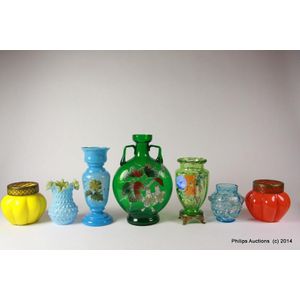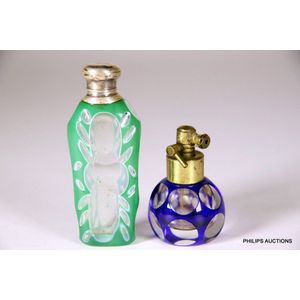Chinese Snuff Bottle Collection
You must be a subscriber, and be logged in to view price and dealer details.
Subscribe Now to view actual auction price for this item
When you subscribe, you have the option of setting the currency in which to display prices to $Au, $US, $NZ or Stg.
- Hornbill - Oriental antique descriptions occasionally refer to "hornbill" or "hornbill ivory" as the material from which the object is made. In fact the hornbill is a large bird, the helmeted hornbill, found in a few South-East Asian countries, and the name is also applied to the material obtained from a growth on the upper section of the beak of the bird, known as a casque.
In its natural form it is a yellow colour, but when the hornbill rubs its beak while preening its feathers, the growth turns a red colour.
As well as being used as a carving material in areas where the bird is found, hornbill became popular as a carving medium with the Chinese in the 19th century, and it was prized (and priced) ahead of ivory and jade.
The helmeted hornbill is listed in Appendix 1 of CITES, (Convention on International Trade in Endangered Species) meaning that trade in hornbill objects requires import and export permits.
the s natural ivory from the bird, native to Indonesia. The hornbill is now an endangered species, but due to the apparent age of the jewelry, this item would be legal for trade. Hornbill ivory is not a true ivory as it is not a dentine material, but rather a keratin. Hornbill ivory of this nature was often carved from the lower layer of the hornbill casque for the western market. The upper area, with a strong red coloration, was traded to the Eastern market. The upper areas of these pieces yet show some of the red coloring. The rest is in the strong yellowish color of natural hornbill.
This item has been included into following indexes:
Visually similar items

Five Victorian vases, and two Czech Tango glass bowls, circa 1860s - 1900, and 1920s/30s for Czech vases, including a blue cased hobnail vase, a frilled, dimpled and hand painted vase, a bronze mounted green baluster vase with handpainted japonaiserie, a B

A collection of 9 antique apothecary jars, comprising of 2 Bristol blue jars with stoppers, 5 ribbed green jars with stoppers, and 2 clear jars with stoppers. Heights 17 cm to 21.5 cm note with original Chemists labels

A Bohemian overlaid perfume bottle and a small overlaid atomiser, circa 1880s, 1920s, a lay down double overlay bottle in green and white colours over white with a screw top lid, and an ovoid atomiser in cobalt and clear glass with flat lens cuts throughou

Antique Chinese carved malachite snuff bottle with quartz stopper. Height 6.2 cm
